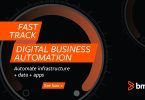In this Run and Reinvent podcast I chat with Chris Haynes, Manager of IT Workload Engineering for Raymond James, about how his company is leveraging Control-M to improve availability through sophisticated automation. Raymond James is a full-service financial investment company with over 8,000 financial advisors across 2,600 locations worldwide. Below is a condensed transcript of our conversation.
Joe Goldberg: Chris, let’s just get right into it – can you tell everyone listening a little bit about Raymond James and about your role there?

Joe: So, I understand that you had some interesting work in that area in the last year? Maybe you could tell us a little bit more about that.
Chris: Right. So, kind of to build off. With my team, we’ve really focused on leveraging all the analytics and data we’re pulling out of Control-M to understand where long poles and problems are in our workflows. A big focus has been continuous improvements. So, with that, we have to, we’re leveraging analytics in lots of different proactive looks, leveraging forecasting using every module out of Control-M to identify gaps in processing, and streamlining workflows to better support our business partners.
Over the last year, a lot of the stuff has really paid dividends and we have really been able to improve on meeting our business, our critical business application SLAs going from 87 percent to 98 percent over the last year. And that’s obviously a big win and a nice star by our name there. So, we’re looking for every opportunity. We’re also trying to give buy-in across the enterprise from everybody in the IT organization to leverage data analytics from Control-M. So, we have pulled data out, we have put that in, created a lot of dashboarding off of those analytics. Some folks have really a real time view of where they’re at and understand trends that are occurring with their business applications. So, that’s really been, from our perspective, my internal evangelizing of Control-M and its capabilities to get folks to buy-in and see where they can make improvements.
Joe: Okay. So, that’s some really interesting stuff about what’s been going on and the history and then some of the things that you’re doing, I think, more recently. But I understand that you’ve been using Control-M, or that Raymond James has been using Control-M, to help run critical parts of the business for quite a long time. And so, perhaps you can expand a little bit about that?
Chris: Right. So, a couple of things just to understand how we’ve grown in that space. We’re probably about seven years in using Control-M at Raymond James. I have been here through the whole growing of it and the implementation, so I’ve had a great view of our partnership there. So, we’ve more than doubled our workload but increasing our performance and again, we’ve taken on more sophisticated applications. What’s been part of the evangelizing part really is we’re able to support applications on platforms, any platform, and multiple environments at a very high rate. So, we really have been able to continue to streamline and support our business.
Really our advisors are looking to make sure their applications are up and available. The greatest ability to them is availability and they want to make sure it’s up. That’s why meeting our SLAs were a critical thing. And part of that as we grow, move forward with all this added sophistication, are the additional modules that Control-M continues to add. A big piece that’s been important over the last year is the Automation API that BMC’s introduced for petroleum. That’s really helped us engage with our software engineering teams as they’re developing new applications for our business partners to really improve their ability to code and test and get that to production in a much more streamlined fashion. And it also gives them really empowerment in their ability to work with a tool, so it’s helped with that buy-in. And we’re continuing to grow that across enterprise.
I’ll tell you when we first started using Control-M six, seven years ago, that with any change it’s, for an enterprise tooler, it’s never everybody is automatically on board. But initially we had about 30 or 40 folks that were using the tool and understanding the value. But now, I have over 500 folks across our IT enterprise using the tool and taking advantage of all the analytics and understanding of the functionalities that it offers. So, that continues to be a part of our future especially as we engage our DevOps team, which in the last couple months that’s been a big thing for us is engaging our DevOps folks to start leveraging Control-M as part of their process. So, we’re in the beginning stages of that, so that’s very exciting.
Joe: So, being in financial services, certainly everyone I think expects that things like audit and compliance or regulatory requirements would be a big deal for you as well. Has Control-M helped you in that area?
Chris: Absolutely. So, a couple of things. I mean, we actually, it’s enabled us actually to move forward with a couple of new applications because of the compliance capabilities. But, from an audit perspective really, it’s cut our time by 96 percent. We’re audited, it’s not a quarterly or monthly, it’s routinely throughout the year. So really the requirements, it used to take us tons of man hours, lots of resource requirements, and we are spitting out reports that would take tons of time to collect. Now we’re doing this in minutes, getting it over. It’s in a format that’s easily viewable and our auditors are much happier because we’re able to give clear, concise reporting in a very much better time frame.
Listen to the full episode from SoundCloud or Apple Podcasts to hear the rest of this interview.
These postings are my own and do not necessarily represent BMC's position, strategies, or opinion.
See an error or have a suggestion? Please let us know by emailing blogs@bmc.com.






